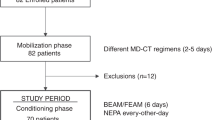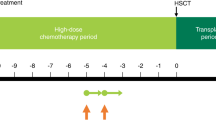Abstract
Stem cell transplantation, using high-dose chemotherapy with or without TBI, is usually associated with significant nausea and vomiting. A variety of antiemetic regimens have been studied to control nausea and vomiting associated with the preparative therapy phase of SCT. We review the most significant studies and highlight the limitations of many of these studies. In addition, we review the few studies with the use of aprepitant as an antiemetic in combination with a 5HT3 antagonist and a steroid. The American Society of Clinical Oncology guideline for antiemetic use for treatment regimens that are highly emetogenic is reviewed regarding recommendations for SCT preparative regimens. On the basis of this review of published data, we recommend the basic outline for an effective antiemetic investigational approach to the study and to the control of nausea and vomiting during the preparative phase of treatment for SCT.
This is a preview of subscription content, access via your institution
Access options
Subscribe to this journal
Receive 12 print issues and online access
$259.00 per year
only $21.58 per issue
Buy this article
- Purchase on Springer Link
- Instant access to full article PDF
Prices may be subject to local taxes which are calculated during checkout

Similar content being viewed by others
References
Jones R, Nieto Y, Rizzo JD, Wall D, Wingard JR, McCarthy P et al. The evolution of the evident-based review: evaluating the science enhances the art of medicine—statement of the steering committee for evidence-based reviews of the American society for blood and marrow transplantation. Biol Blood Marrow Transplant 2005; 11: 819–822.
Kris MG, Hesketh PJ, Somerfield MR, Feyer P, Clark-Snow R, Koeller JM et al. American society of clinical oncology guideline for antiemetics in oncology: update 2006. J Clin Oncol 2006; 24: 2932–2947.
Or R, Drakos P, Anagler A, Naparstek E, Kapeluschnik J, Cass Y . The anti-emetic efficacytolerability of tropisetron in patients conditioned with high-dose chemotherapy [with and without total body irradiation] prior to bone marrow transplantation. Support Care Cancer 1994, 245–248.
Barbounis V, Koumakis G, Vassilomanolakis M, Hatzichristou H, Tsousis S, Efremidis AP . A phase II study of ondansetron as antiemetic prophylaxis in patients receiving high-dose polychemotherapy and stem cell transplantation. Support Care Cancer 1995; 3: 301–306.
Agura ED, Cleveland Brown M, Schaffer R, Donaldson G, Shen DD . Antiemetic efficacy pharmacokinetics of intravenous ondansetron infusion during chemotherapy conditioning for bone marrow transplant. Bone Marrow Transplant 1995; 16: 213–222.
Nahata MC, Hui LN, Koepke J . Efficacy safety of ondansetron in pediatric patients undergoing bone marrow transplantation. Clin Ther 1996, 466–476.
Frakes LA, Brehm TL, Kosty MP, Miller WE, McMillan RL, Mason J et al. An all oral antiemetic regimen for patients undergoing high-dose chemotherapy with peripheral blood stem cell transplant. Bone Marrow Transplant 1997; 20: 473–478.
Fauser AA, Russ W, Bischoff M . Oral dolasetron mesilate [MDL 73,147EF] for the control of emesis during fractionated total-body irradiation and high-dose cyclophosphamide in patients undergoing allogeneic bone marrow transplantation. Support Care Cancer 1997; 5: 219–222.
Broun ER, Nichols CR, Gize G, Cornetta K, Hromas RA, Schacht B et al. Tandem high dose chemotherapy with autologous bone marrow trasnplantaton for initial relapse of testicular germ cell cancer. Cancer 1997; 79: 1605–1610.
Osowski CL, Dix SP, Lynn M, Davidson T, Cohen L, Miyahara T et al. An open-label dose comparison study of ondansetron for the prevention of emesis associated with chemotherapy prior to bone marrow transplantation. Support Care Cancer 1998; 6: 511–517.
Barbounis V, Koumakis G, Hatzichristou H, Vassilomanolakis M, Tsoussis S, Efremidis A . The anti-emetic efficacy of tropisetron plus dexamethasone in patients treated with high-dose chemotherapy stem cell transplantation. Support Care Cancer 1999, 79–83.
Orchard PJ, Rogoscheske J, Burns L, Rydholm N, Larson H, DeFor TE et al. A prospective randomized trial of the anti-emetic efficacy of ondansetron and granisetron during bone marrow transplantation. Biol Blood Marrow Transplant 1999; 5: 386–393.
Spitzer TR, Friedman CJ, Bushnell W, Frankel SR, Raschko J . Double-blind randomized parallel-group study on the efficacy safety of oral granisetron oral ondansetron in the prophylaxis of nausea vomiting in patients receiving hyperfractionated total body irradiation. Bone Marrow Trans 2000; 26: 203–210.
Walsh T, Morris AK, Holle LM, Callander N, Bradshaw P, Valley AW et al. Granisetron vs ondansetron for prevention of nausea and vomiting in hematopoietic stem cell transplant patients: results of a prospective, double-blind, randomized trial. Bone Marrow Trans 2004; 34: 963–968.
Barnett CM, Oholendt MS, Popat U, Carrum G, Heslop HE . Evaluation of aprepitant for treatment of acute and delayed chemotherapy-inducted nausea and vomiting in patients undergoing autologous stem cell transplantation. Blood 2004; 104: 343b (abstract no. 5041).
Junagadhwalla M, Chilton J, Gentile T . Prolonged administration of aprepitant does not increase toxicity in patients undergoing high dose chemotherapy and autologous stem cell transplant. Blood 2005; 106: 417b (abstract no. 5329).
Gralla RJ, Carides AD, Ianus J, Elmer M, Evans JK, Horgan KJ . The oral neurokinin-1 antagonist aprepitant added to standard antiemetics provided equal efficacy in female and male patients receiving highly emetogenic chemotherapy: combined data from 2 phase III clinical trials. Presented at the European Bone Marrow Transplant meeting, March 2006.
Szer J, Grigg AP, Roberts AW, Raunow H . Aprepitant in the prevention of acute and delayed nausea and vomiting following haemopoietic stem cell transplantation: a pilot study. 32nd Annual Meeting of the European Group for Blood and Marrow Transplantation. 2006. Bone Marrow Transplant 2006; 37 (Suppl 1): S112.
Adel NG, Khan A, Lucarelli C . Use of palonosetron 0.25 mg IV daily and incidence of nausea and vomiting in patients undergoing bone marrow transplantation. J Clin Oncol 2006 ASCO annual meeting proceedings part I. 2006; 24 (abstract no. 16510).
Bubalo JS, Leis JF, Curin PT, Kovascovics TJ, Meyers G, Hayes-Lattin B et al. A double blinded pilot study of aprepitant vs placebo combined with standard antiemetics for the control of nausea and vomiting during hematopoietic cell transplantation. Biol Blood Marrow Transplant 2007; 13: 152.
Bubalo JS, Leis JF, Curtin PT, Maziarz RT, Kovascovics TJ, Meyers G et al. A randomized, double-blinded, pilot trial of aprepitant added to standard antiemetics during conditioning therapy for hematopoietic stem cell transplant (HSCT). J Clin Onc 2007; 25 (no. 18S): 9112.
Hornby PJ . Central neurocircuitry associated with emesis. Am J Med 2001; 111 (BA): 106S–112S.
Diemunsch P, Grelot L . Potential of substance P antagonists as antiemetics. Drugs 2000; 60: 533–546.
Higa GM, Auber ML, Altaha R, Piktel D, Kurian S, Hobbs G et al. 5-hydroxyindoleacetic acid and substance P profiles in patients receiving emetogenic chemotherapy. J Onc Pharm Practice 2006; 12: 201–209.
Slatkin NE . Cannabinoids in the treatment of chemotherapy-induced nausea and vomiting: beyond prevention of acute emesis. J Support Oncol 2007; 5 (5 Suppl 3): 1–9.
Hesketh PJ . Chemotherapy-induced nausea and vomiting. N Engl J Med 2008; 358: 2482–2494.
Warr DG, Hesketh PJ, Gralla RJ, Muss HB, Herrstedt J, Eisenberg PD et al. Efficacy and tolerability of aprepitant for the prevention of chemotherapy-induced nausea and vomiting in patients with breast cancer after moderately emetogenic chemotherapy. J Clin Oncol 2005; 23: 2822–2830.
Buchali A, Feyer P, Groll J, Massenkeil G, Arnold R, Budach V . Immediate toxicity during fractionated total body irradiation as conditioning for bone marrow transplantation. Radiotherapy Onc 2000; 54: 157–162.
Wong RKS, Paul N, Ding K, Whitehead M, Brundate M, Fyles A et al. 5-hydroxytroptamine-3 receptor ntagonist with or without short-course dexamethasone in the prophylaxis of radiation induced emesis: a placebo-controlled randomized trial of the national cancer institute of Canada clinical trials group (SC19). J Clin Oncol 2006; 24: 3458–3464.
Marcacci G, Becchimanzi C, Corazzelli G, Frigeri F, Russo F, Pinto A . Single dose palonosetron for the prevention of acute and delayed nausea and vomiting in patients undergoing HDCT and stem cell transplantation. Support Care Cancer 2008; 16:636: 596–597.
Mendoza F, Mangan K, Maziarz R, Hurd D, DeGroot T, Schuster M . Multiple-day dosing of palonosetron may enhance emesis and nausea prevention in patients receiving high-dose melphalan chemotherapy prior to stem cell transplant. Support Care Cancer 2008; 16: 637.
Higa GM, Auber L, Altaha R, Hobbs G . Concordance between substance P levels and antiemetic guidelines. J Clin Oncol 2008; 26: 514S (May 20 suppl; abstract no. 9552).
Author information
Authors and Affiliations
Corresponding author
Rights and permissions
About this article
Cite this article
Trigg, M., Inverso, D. Nausea and vomiting with high-dose chemotherapy and stem cell rescue therapy: a review of antiemetic regimens. Bone Marrow Transplant 42, 501–506 (2008). https://doi.org/10.1038/bmt.2008.257
Received:
Revised:
Accepted:
Published:
Issue Date:
DOI: https://doi.org/10.1038/bmt.2008.257
Keywords
This article is cited by
-
Mitigating acute chemotherapy-associated adverse events in patients with cancer
Nature Reviews Clinical Oncology (2022)
-
Antiemetic Strategies in Patients Who Undergo Hematopoietic Stem Cell Transplantation
Clinical Hematology International (2022)
-
Efficacy and safety of netupitant/palonosetron combination (NEPA) in preventing nausea and vomiting in non-Hodgkin’s lymphoma patients undergoing to chemomobilization before autologous stem cell transplantation
Supportive Care in Cancer (2022)
-
Efficacy and safety of multiple doses of NEPA without dexamethasone in preventing nausea and vomiting induced by multiple-day and high-dose chemotherapy in patients with non-Hodgkin’s lymphoma undergoing autologous hematopoietic stem cell transplantation: a phase IIa, multicenter study
Bone Marrow Transplantation (2020)
-
Long-term aprepitant for nausea and vomiting associated with gastroparesis in hematopoietic stem cell transplantation
Bone Marrow Transplantation (2018)



